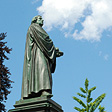WILHELMSBURG CASTLE - SCHMALKALDEN
Renaissance, Reformation and the Schmalkaldic League
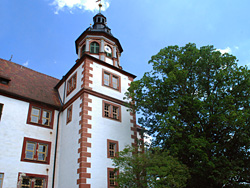 Wilhelmsburg Castle is set on a hill above the late medieval town center of Schmalkalden and is one of the most significant Renaissance era castles in Germany for its nearly original state. Today Schmalkalden is a smallish tourist town now in western modern Thuringia in the midst of the ancient forest, which had been part of East Germany until the reunification, but in the 16th Century was the second largest city in the lands of Hesse, which is why it plays an outsized role in the history of the Protestant reformation.
Wilhelmsburg Castle is set on a hill above the late medieval town center of Schmalkalden and is one of the most significant Renaissance era castles in Germany for its nearly original state. Today Schmalkalden is a smallish tourist town now in western modern Thuringia in the midst of the ancient forest, which had been part of East Germany until the reunification, but in the 16th Century was the second largest city in the lands of Hesse, which is why it plays an outsized role in the history of the Protestant reformation.
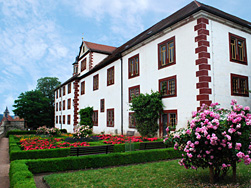 The castle has been used as a museum for century and half, and a recent exhibit has opened in its halls to celebrate the 500th Anniversary of Martin Luther. Though the castle itself was built after Luther’s time in Schmalkalden (see St Georg Church), the exhibit present the close connection between the reformer and the castle’s landlords and the events of story. “The Schmalkaldic League: Political Arm of the Reformation” explores Luther and the spread of the Reformation in the political conflicts between Protestants and Catholics up until the Peace of Augsburg.
The castle has been used as a museum for century and half, and a recent exhibit has opened in its halls to celebrate the 500th Anniversary of Martin Luther. Though the castle itself was built after Luther’s time in Schmalkalden (see St Georg Church), the exhibit present the close connection between the reformer and the castle’s landlords and the events of story. “The Schmalkaldic League: Political Arm of the Reformation” explores Luther and the spread of the Reformation in the political conflicts between Protestants and Catholics up until the Peace of Augsburg.
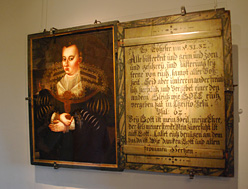 Phillip I, Landgrave of Hesse was one of earliest and strongest supporters of the ideas of Martin Luther, whom he had met at the Imperial Diet of Worms (see Luther at Worms) in 1521 when he was just 17 years old. Luther had been called to Worms to answer to answer for his explosive 95 Theses, which Luther refused to recant. The imperial reaction was to call for Luther’s arrest, but Phillip was impressed with Luther. In 1525, he established the first evangelical church in Hesse, taken the first official step toward reformation.
Phillip I, Landgrave of Hesse was one of earliest and strongest supporters of the ideas of Martin Luther, whom he had met at the Imperial Diet of Worms (see Luther at Worms) in 1521 when he was just 17 years old. Luther had been called to Worms to answer to answer for his explosive 95 Theses, which Luther refused to recant. The imperial reaction was to call for Luther’s arrest, but Phillip was impressed with Luther. In 1525, he established the first evangelical church in Hesse, taken the first official step toward reformation.
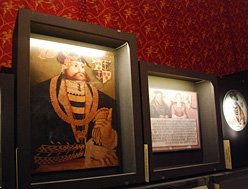 In how many of these things begin as a family squabble, a fight among cousins, Phillip's younger sister had married John of Saxony of the ducal line of Wettins in 1516. This brought Phillip into conflict with his father-in-law, the Catholic adherent George, Duke of Saxony in Dresden, while his cousin, the Elector of Saxony John Frederick in Tourgau, took the Protestant side. In 1531, Phillip of Hesse joined with John Frederick of Saxony and other protestant leaning landholders to form the Schmalkaldic League, pledging to defend each other should their territories be attacked by Charles V, the German Holy Roman Emperor.
In how many of these things begin as a family squabble, a fight among cousins, Phillip's younger sister had married John of Saxony of the ducal line of Wettins in 1516. This brought Phillip into conflict with his father-in-law, the Catholic adherent George, Duke of Saxony in Dresden, while his cousin, the Elector of Saxony John Frederick in Tourgau, took the Protestant side. In 1531, Phillip of Hesse joined with John Frederick of Saxony and other protestant leaning landholders to form the Schmalkaldic League, pledging to defend each other should their territories be attacked by Charles V, the German Holy Roman Emperor.
The members of the informal joint alliances gathered in Schmalkalden in 1537 to plan their course together and sign on to common action. Martin Luther preached to the assembled lords in the St Georg Church and presented the tenants of the Lutheran Augsburg Confessions doctrine in the Schmalkald Articles, to which the league all pledged to support in their lands.
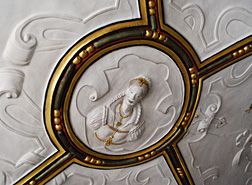 One of the prominent figures among the dukes and princes at Schmalkalden was Elizabeth of Hesse also called Elizabeth of Rochlitz, the only female member of the Schmalkaldic League. She was Phillip’s sister married to John, Duke of Saxony. But John had died in January of that year and as his widow, Elisabeth took his place at the table. She had inherited the castles of Rochlitz and Kriebstein in Saxony (see Rochlitz Castle Reformation and Knight's Castle Kriebstein) and was as staunch a supporter of Martin Luther as her brother. Her possession of the castle is commemorated in the ceiling motif still remaining in the castle chapel.
One of the prominent figures among the dukes and princes at Schmalkalden was Elizabeth of Hesse also called Elizabeth of Rochlitz, the only female member of the Schmalkaldic League. She was Phillip’s sister married to John, Duke of Saxony. But John had died in January of that year and as his widow, Elisabeth took his place at the table. She had inherited the castles of Rochlitz and Kriebstein in Saxony (see Rochlitz Castle Reformation and Knight's Castle Kriebstein) and was as staunch a supporter of Martin Luther as her brother. Her possession of the castle is commemorated in the ceiling motif still remaining in the castle chapel.
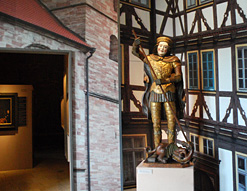 The League eventually lost on the battlefield at Mühlberg to the allies Charles V in 1547, but faced with the threat of the Ottoman Empire Muslims of Suleiman the Magnificent from the east, to avoid a two front conflict, the emperor signed the Peace of Passau with the league members, allowing the princes to the north to choose which religion would be practiced in their territories, essentially cementing the Protestant Reformation in Germany for the next 500 years. After the defeat of the League Phillip gifted Elizabeth the Hessen part of Schmalkalden, as a widow seat (Wittum) and she lived in the former medieval castle until her death in 1557.
The League eventually lost on the battlefield at Mühlberg to the allies Charles V in 1547, but faced with the threat of the Ottoman Empire Muslims of Suleiman the Magnificent from the east, to avoid a two front conflict, the emperor signed the Peace of Passau with the league members, allowing the princes to the north to choose which religion would be practiced in their territories, essentially cementing the Protestant Reformation in Germany for the next 500 years. After the defeat of the League Phillip gifted Elizabeth the Hessen part of Schmalkalden, as a widow seat (Wittum) and she lived in the former medieval castle until her death in 1557.
William IV (William the Wise) succeeded his father Philip in 1567 as the Landgrave of Hesse-Kassel, gaining half of his father’s lands and became the sole inheritor of the lordship of Schmalkalden in 1583 with the death of the last Franconian Henneberg line, with whom it had been shared. His main seat was in Kassel but he decided to upgrade his secondary residence in Schmalkalken as a show of his new position. He had the previous Romanesque medieval Waltaff Castle from 12th Century and a former nearby abandoned Catholic abbey demolished and started fresh, building the castle, named for himself, on the same spot.
The castle was opened for residence on May 23 of 1590, though it wasn’t completed until 1618. One of the reasons it remains mostly original is unlike other palaces which get remodeled over time, the Hessian Landgraves used the castle for a few generations, but lost its place as a family residence during the reorganization of German states under Napoleon in 1803, it was mostly abandoned. Rather than being renovated like many others in the Victorian era, it remained an orphan. In 1873, the Association for Henneberg History and Geography purchased the castle and began using it as a museum.
Exhibition "The Schmalkalic League - Political Arm of the Reformation!
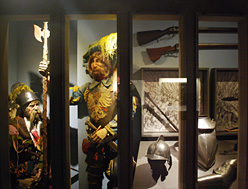 The Schmalkaldic League included fifty members states ranging from Strasbourg to Bremen, Hamburg to Augsburg and Constance with the large principalities of Saxony and Hesse, the Duchy of Wurttemberg, the Brunswick-Luneburg, all united in one cause. The new semi-permanent exhibition presented at the Wilhelmsburg Museum Palace presents a variety of animation and multimedia exhibits as well as artifacts and document exhibits telling the story of the rise and fall of the Schmalkaldian League. Look for the wall of all the reformation figures as it tends to get complicated. The exhibit is in German only and will remain for the foreseeable future.
The Schmalkaldic League included fifty members states ranging from Strasbourg to Bremen, Hamburg to Augsburg and Constance with the large principalities of Saxony and Hesse, the Duchy of Wurttemberg, the Brunswick-Luneburg, all united in one cause. The new semi-permanent exhibition presented at the Wilhelmsburg Museum Palace presents a variety of animation and multimedia exhibits as well as artifacts and document exhibits telling the story of the rise and fall of the Schmalkaldian League. Look for the wall of all the reformation figures as it tends to get complicated. The exhibit is in German only and will remain for the foreseeable future.
Wilhemsburg Residence Palace Castle
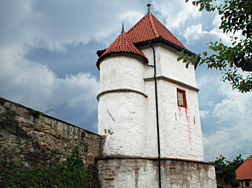 Some of the castle rooms are obscured by the exhibition displays. The layout is a four-winged structure in a square surrounding a courtyard, typical for a purely residential palace of the late 16th century. The castle encompasses a parade ground on the hill with a view of the town, a gatekeeper's house, a flowering formal garden, stables, a bakery and a brewery. There is one remaining round tower left from the former medieval castle which served as a prison tower, incorporated in a wall behind the palace. The interior furnishings (now mostly gone) were procured from the Wilhelmshöhe Palaces in Kassel when William IV’s son, Maurice, who succeeded him as Landgrave of Hesse resided at the Wilhelmsburg palace. The Festaal, also called the Giant's Hall, is one largest festival halls of the 16th century in Germany, still retains its original style of decoration and still in use for gatherings and performances.
Some of the castle rooms are obscured by the exhibition displays. The layout is a four-winged structure in a square surrounding a courtyard, typical for a purely residential palace of the late 16th century. The castle encompasses a parade ground on the hill with a view of the town, a gatekeeper's house, a flowering formal garden, stables, a bakery and a brewery. There is one remaining round tower left from the former medieval castle which served as a prison tower, incorporated in a wall behind the palace. The interior furnishings (now mostly gone) were procured from the Wilhelmshöhe Palaces in Kassel when William IV’s son, Maurice, who succeeded him as Landgrave of Hesse resided at the Wilhelmsburg palace. The Festaal, also called the Giant's Hall, is one largest festival halls of the 16th century in Germany, still retains its original style of decoration and still in use for gatherings and performances.
Castle Church and Organ
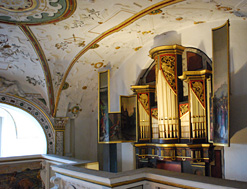 The castle church at Wilhelmsburg was closely modeled on the one at Torgau, which was the first Reformation church, where the first time in Germany, the altar, the pulpit and the organ were placed one above the other on three levels. Unfortunately, in more recent times someone had the idea of allowing a local artist to paint modern murals on the plain protestant walls of the chapel, so an otherwise magnificent example of Renaissance architecture looks a bit like a propaganda poster for the proletariat.
The castle church at Wilhelmsburg was closely modeled on the one at Torgau, which was the first Reformation church, where the first time in Germany, the altar, the pulpit and the organ were placed one above the other on three levels. Unfortunately, in more recent times someone had the idea of allowing a local artist to paint modern murals on the plain protestant walls of the chapel, so an otherwise magnificent example of Renaissance architecture looks a bit like a propaganda poster for the proletariat.
Visiting Wilhelmsburg Castle Schmalkalden
Open hours for Wilhelmsburg is 10am to 6pm daily from April 1 to October 31 and winter hours 10am to 4pm Tuesday to Sunday (closed Monday) November through March. Admission for adults is €6, Reduction (Seniors, Students) €4, with a Family Card for €12. The Schmalkaldic League Exhibition is included in admission. © Bargain Travel EuropeFind best hotel and vacation deals in Schmalkalden on TripAdvisor
Web Info
Schloss Wilhelmsburg
These articles are copyrighted and the sole property of Bargain Travel Europe and WLPV, LLC. and may not be copied or reprinted without permission.
See Also:
500th ANNIVERSARY MARTIN LUTHER - WARTBURG CASTLE
MARKET CHURCH HALLE - MARTIN LUTHER DEATH MASK

